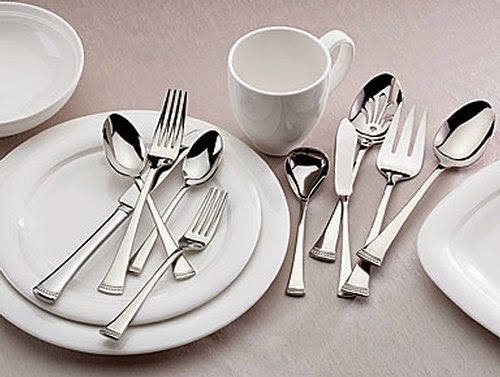I have used, purchased, broken, cherished, tried and discarded many different styles and types of flatware in my lifetime. And I have learned a secret: 'Not all flatware is created equal.' Even comparably priced flatware varies in several important ways. And nowhere is it so evident as it is in flatware options, that you get what you pay for. Here are some considerations for anyone planning to begin a bridal registry, set up housekeeping, purchase new flatware or replace flatware.
- Explore flatware craftsmanship. The metal used in flatware is developed into utensils by two different processes.
- Drop-forged or forged: In this process the piece is made individually by a molding process. Forged or drop-forged flatware is heavier, denser and has smooth rounded edges. Forged is a higher process and generates a safer utensil that resists chips, breaking and contamination. Forged flatware is stainless as well. The forged piece is treated and sealed to stay smooth and untarnished. Look for flatware labeled as 'forged'. Feel the pieces; you will notice the smoother metal.
- Die-cut or stamped: In this process, flatware pieces are cut or punched from a sheet of lower quality pot-metal and then formed. The process leaves rougher edges that can be sharp. The metal is less pure and will discolor. It is usually not sealed or heat-treated to resist damage from heat, chemicals and daily use. The metal is also pitted and can retain contaminants. Die-cut costs less but is not worth the savings.
- Compare alloys and metals used in the flatware. When I was young, people had everyday flatware, made of stainless steel or pot-metal, and good silver, made from nickel, sterling silver, pewter or even gold-plating. We've looked at why pot-metal is not a wise choice for an eating utensil. Let's look at the other choices.
- Stainless: The least expensive of the better flatware choices, stainless is a good choice for daily use because it doesn't require polishing. Stainless resists stains and of course germs as well. It is dishwasher safe.
- Nickel-plate: This is an attractive, dull silver color. It does require polishing and studies are showing that constant exposure to nickel can be dangerous. Nickel silverware also retains its value. Nickel should not be used for everyday use.
- Sterling silver: This is the coup de grace in elegant silver, with its soft, delicate shine. Sterling does stain and it must be polished meticulously after use. Silver polish is very toxic, so if you own and use sterling, use a Mr. Clean Magic Eraser to polish. You can also remove stains with hydrogen peroxide, vinegar or lemon juice and polish with baking soda.
- Pewter: Pewter is a lead-based metal and therefore very toxic. Pewter should be used as a collectible only and should never actually come in contact with food. Avoid handling pewter too much also.
- Gold-plate: This came into vogue about 30 years ago. Gold-plate has all the drawbacks of silver, as well as the fact that any plated metal can chip or flake.
- Consider Design: Good flatware is signed as a pattern or series so that you can order replacement or completer-pieces in matching design. This is useful if you plan to add to your collection or when you are registering as a bride. If guests know your chosen pattern, they can purchase place settings or accessories like serving pieces. When you select a pattern, remember:
- Table service (dishes, glassware, etc). Choose complimentary patterns.
- Your table linens: tablecloth, napkins, napkin rings.
- Your general decor; flatware generally falls into three categories.
- Classic -- simple curves and little adornment.
- Contemporary -- art deco, geometric designs, Greek designs.
- Traditional -- flowers, scrollwork.
- Can you get replacement pieces? How? Where?
- Purchase at least an 8-setting service. Less than 8 settings will not give you enough for any entertaining. A setting includes soup spoon, teaspoon, knife, salad fork and dinner fork. You can choose the more contemporary 3-piece setting of teaspoon, dinner fork and knife depending upon your lifestyle.
- Choose reputable companies. Flatware manufactured in the USA, Germany, Italy, France or other western European nations is generally of better quality and must follow certain stricter purity laws in production.
- You should have a warranty on the flatware.
- Look for the Good Housekeeping seal when you shop.
- Oneida is probably the most widely recognized and oldest flatware manufacturer. Oneida offers a very affordable line of flatware as well as more expensive silver.
- Michael C. Fina has a good reputation as well.
- Purchase or make sure your package comes with a wooden, fabric-lined box for storing nickel, sterling and gold-plate. This will protect from scratches.
- Include any valuable silver or flatware in your house insurance (possessions section). You might insure the silverware separately depending upon its worth (complete sets of sterling, retired patterns, vintage silver).
Flatware is a traditional part of family life. I have come to cherish my orignal wedding service, even though it wasn't expensive. It brings back 20 years of happy memories.










